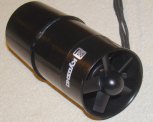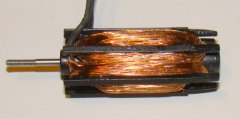| Prop | Volts | Amps | Watts | rpm | Thrust | Efficiency |
| - | 7.0 | 0.3 | 2.7 | - | - | - |
| - | 10.5 | 0.4 | 4.5 | - | - | - |
| 2x0 | 7.0 | 2.4 | 17 | 45500 | - | 78% |
| DF45 | 7.0 | 4.9 | 34 | 41600 | 97 | 82% |
| DF45 | 10.5 | 9.4 | 98 | 59520 | 200 | 83% |

|
|
| Prop | Volts | Amps | Watts | rpm | Thrust | Efficiency |
| - | 7.0 | 0.3 | 2.7 | - | - | - |
| - | 10.5 | 0.4 | 4.5 | - | - | - |
| 2x0 | 7.0 | 2.4 | 17 | 45500 | - | 78% |
| DF45 | 7.0 | 4.9 | 34 | 41600 | 97 | 82% |
| DF45 | 10.5 | 9.4 | 98 | 59520 | 200 | 83% |

|
|
This is the fan unit that Kyosho supply with their Illusion and Mirage jets. The motor is an integral part of the fan. The fan shroud, stator fins and motor case are all molded as a single unit. The rear cone is permanently glued onto the back of the motor. The fan rotor is held on via a screw thread on the motor shaft, and there is a screwdriver slot on the back end of the shaft to allow the rotor to be removed. The motor is coreless and ironless, and has good bearings so it turns very freely.
 At first I though that my fan was unbalanced, because if I rotated the shroud
the rotor would remain stationary, with one (heavier?) blade always pointing down.
Then I discovered it also did this if the fan was held vertical. Obviously it wasn't
being affected by gravity, so what was the cause? The rotor was aligning itself to
the Earth's magnetic field!
At first I though that my fan was unbalanced, because if I rotated the shroud
the rotor would remain stationary, with one (heavier?) blade always pointing down.
Then I discovered it also did this if the fan was held vertical. Obviously it wasn't
being affected by gravity, so what was the cause? The rotor was aligning itself to
the Earth's magnetic field!
I was suprised to fnd that the coreless motor has very good efficiency, achieving well over 80% on 3S Lipo. This is significantly better than most other motors of this size. The complete lack of iron contributes to exceptionally low magnetic losses at high rpm.